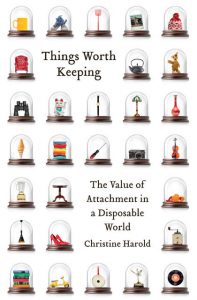Christine Harold is Professor and Chair of the Department of Communication. Her scholarship analyzes the rhetoric of consumer capitalism and explores opportunities for meaningful political action in a world increasingly defined by the logic of the marketplace.

Her latest book, Things Worth Keeping: The Value of Attachment in a Disposable World (2020, University of Minnesota Press), looks at the relationship between mass production, product attachment, and consumer waste. This work builds off of her first book, OurSpace: Resisting the Corporate Control of Culture (2007, 2009 University of Minnesota Press) which evaluates strategies of resistance to branding and the commercialization of public life.
Among other venues, Harold’s work has appeared in Public Culture, Rhetoric and Public Affairs, Critical Studies in Media Communication, and JAC. She serves on the editorial boards of the Quarterly Journal of Speech, Western Journal of Communication, and Communication and Critical/Cultural Studies.
Recent courses include:
- Introduction to Rhetoric
- Rhetoric and Popular Culture
- Thing Theory: Rhetoric and Material Culture
- Rhetorics of Commerce, Consumption, and Community
Selected publications
- Harold, C. (2020). Things Worth Keeping: The Value of Attachment in a Disposable World. Minneapolis: University of Minnesota Press.
- Harold, C. (2015). “The Big One that Got Away” in Michael Moore and the Rhetoric of Documentary, Thomas W. Benson and Brian Snee, eds. Carbondale: Southern Illinois University Press.
- Harold, C. (2015). “Motherhood and the Necessity of Invention: The Possibilities of Play in a Culture of Consumption,” in The Motherhood Business: Consumption, Communication, and Privilege, Anne T. Demo and Jennifer L. Borda, eds. Tuscaloosa: University of Alabama Press.
- Harold, C. (2013). “A Brand Called You!: Ethos, Community, and the Selling of Self in the Web 2.0 Marketplace” in The Routledge Companion to Advertising and Promotional Culture, Matt McAllister and Emily West, eds. New York, London: Routledge.
- Harold, C. (2007). OurSpace: Resisting the Corporate Control of Culture. Minneapolis: University of Minnesota Press.
- Harold, C. (2009). On Target: Aura, Affect, and the Rhetoric of ‘Design Democracy’. Public Culture: an Interdisciplinary Journal of Transnational Cultural Studies, 21(3), 599-618.
- DeLuca, K.M., Harold, C., Rufo, K. (2007). Q.U.I.L.T.: A Patchwork of Reflections (honoring the 20th anniversary of AIDS Memorial Quilt). Rhetoric and Public Affairs, 10(4), 627-623.
[Reprinted in Morris, C.E. ed. (forthcoming) Remembering the Quilt. East Lansing, MI: Michigan State University Press.] - Harold, C., DeLuca, K.M. (2005) Behold the Corpse: Image Rhetoric and the Lynching of Emmett Till. Rhetoric and Public Affairs, 8(2), 263-286.
[Reprinted Olson, L., Finnegan, C., Hope, D. eds. (2008). Visual Rhetoric: A Reader in Communication and American Culture. Thousand Oaks, CA: Sage Publishing.] - Harold, C. (2004). Pranking Rhetoric: ‘Culture Jamming’ as Media Activism. Critical Studies in Media Communication, 21.3, 189-211.[Reprinted in Turow, J. and McAllister, M. (2009) The Advertising and Consumer Culture Reader. London, New York: Routledge.]
[Reprinted in DeLaure and Fink, (2017) Culture Jamming: Activism and the Art of Cultural Resistance. New York: NYU Press.] - Harold, C. (2001) The Green Virus: Purity and Contamination in Ralph Nader’s 2000 Presidential Campaign. Rhetoric and Public Affairs, 4(4), 581-603.
- Harold, C. (2000). The Rhetorical Function of the Abject Body: Transgressive Corporeality in Trainspotting. JAC: Rhetoric, Writing, Culture, Politics, 20(4), 865-881.
- Harold, C. (1999). Tracking Heroin Chic: The Abject Body Reconfigures the Rational Argument. Argumentation and Advocacy 36 (2), 65-76.

